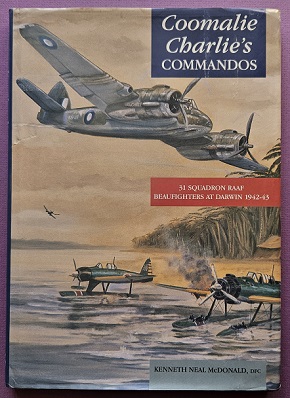Description
Title: A Brief History of No.7 Squadron, Royal Australian Air Force
Author:
Condition: Good
Edition: 1st Edition
Publication Date: 1955
ISBN: N/A
Cover: Soft Cover without Dust Jacket – 21 pages
Comments: The brief history of No 7 Squadron, RAAF. Now a scarce and highly sought after title.
When 7 Squadron was reformed at Laverton in Victoria on 27 June 1940 it was to be equipped with Hudson aircraft. However, due to supply shortages the unit was without aircraft for 18 months. Its handful of airmen operated with 2 Squadron to gain experience. From April 1942 the now independent 7 Squadron deployed aircraft on coastal patrols, seaward searches, and anti-submarine patrols. An attack on an enemy submarine south-west of Gabo Island on 4 June was the squadron’s first action.
In August the squadron moved to Nowra, where it was re-equipped with Beauforts, and then to the Ross River strip in Townsville. Serving as a bomber–reconnaissance squadron, unit aircraft attacked submarines, conducted patrols and escort duties between the Australian mainland and New Guinea, and dropped supplies to the survivors of the vessel Patcan. For much of 1943 7 Squadron aircraft continued with convoy and reconnaissance duties around the Gulf of Carpentaria and south-west New Guinea.
Bombing raids commenced from Horn Island on 27 November 1943 with an attack on shipping in Kokenau area, Keaukwa village, and the Timoeka airstrip. Early the following year the unit moved to Higgins Field, close to the tip of Cape York Peninsula. Continuing with their patrol duties, several aircraft attacked targets in southern Dutch New Guinea. By the end of October the unit had relocated to Tadji airfield near Aitape, where operations against Japanese positions in Niap and Wewak commenced within the week. Eight aircraft also took part in the rescue of an American bomber crew forced to land at sea just of the Wewak coast on 11 November 1944.
7 Squadron supported the 6th Division as it pushed from Aitape towards Wewak, bombing defensive positions and occupied villages, and patrolling for submarines used to resupply Japanese forces. For two months after the capture of Wewak, aircraft attacked Japanese who had retreated inland, in particular to the desperate battles around Mt Tazaki and Mt Shiborangu.
At the close of hostilities 7 Squadron dropped propaganda and surrender leaflets and undertook travel and courier flights. The unit was officially disbanded on 19 December 1945.
Spine repaired by tape otherwise a good copy of an extremely scarce publication.
Also comes with:
No.7 Squadron 40th Annual Reunion (1985) booklet
No.7 Squadron 50th Annual Reunion (1995) booklet
Newspaper clippings


